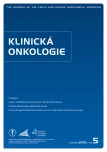Rectal Neuroendocrine Tumours
Authors:
O. Louthan
Authors‘ workplace:
IV. interní klinika 1. lékařské fakulty UK a VFN, Praha
Published in:
Klin Onkol 2009; 22(5): 195-201
Category:
Reviews
Overview
Rectal neuroendocrine tumours (carcinoids) belong to the hindgut carcinoid group, according to older classification. They are not associated with carcinoid syndrome. Colonoscopy is a gold standard for detecting rectal carcinoids. Endosonography is important for assessing rectal carcinoid growth. CT colonography and 111In-octreotide scanning is required for staging if residual or metastatic disease is suspected. Serum chromogranin A and acid phosphatase are necessary biochemical markers. Local resection is sufficient for small tumours, anterior resection for rectal tumours > 2cm is appropriate. There is no evidence base for adjuvant therapy. Patients with rectal carcinoids < 2cm have a very good prognosis with long term survival.
Key words:
carcinoid – rectal cancer – chromogranin A – OctreoScan – endosonography – therapy
Sources
1. Williams ED, Sandler M. The classification of carcinoid tumours. Lancet 1963; 281 : 238–239.
2. Modlin IM, Kidd M, Latich I et al. Current status of gastrointestinal carcinoids. Gastroenterology 2005; 128 : 1717–1751.
3. Modlin IM, Lye KD, Kidd M. A 5-decade analysis of 13 715 carcinoid tumours. Cancer 2003; 97 : 934–959.
4. Jetmore AB, Ray JE, Gathright JB et al. Rectal carcinoids: the most frequent carcinoid tumor. Dis Colon Rectum 1992; 35 : 717–725.
5. Capella C, Heitz PU, Hofler H et al. Revised classification of neuroendocrine tumours of the lung, pancreas and gut. Virchows Arch 1995; 425 : 547–560.
6. Onogawa S, Tanaka S, Oka S et al. Clinical significance of angiogenesis in rectal carcinoid tumors. Oncol Rep 2002; 9 : 489–494.
7. Shimizu T, Tanaka S, Haruma K et al. Growth characteristics of rectal carcinoid tumors. Oncology 2000; 59 : 229–237.
8. Hotta K, Shimoda T, Nakanishi Y et al. Usefulness Ki-67 for predicting the metastatic potential of rectal carcinoids. Pathol Int 2006; 56 : 591–596.
9. Solcia E, Klöppel G, Sobin LH. Histological typing of endocrine tumours. Springer-Verlag 2000.
10. Modlin IM, Öberg IK. A Century of Advances in Neuroendocrine Tumor Biology and Treatment. Published by Felsenstein C.C.C.P.: 464.
11. Öberg K. Neuroendocrine gastrointestinal tumours. Annals of Oncology 1996; 7 : 453–463.
12. Öberg K. Carcinoid Tumors: Current Concepts in Diagnosis and Treatment. The Oncologist 1998; 3 : 339–345.
13. Matsumoto T, Iida M, Suekane H et al. Endoscopic ultrasonography in rectal carcinoid tumors: contribution to selection of therapy. Gastrointest Endosc 1991; 37 : 539–542.
14. Banzo J, Vidal-Sicat S, Prats E et al. In-111 DTPA octreotide scintigraphy and intraoperative gamma probe detection in the diagnosis and treatment of residual lymph node metastases of a rectal carcinoid tumor. Clin Nucl Med 2005; 30 : 308–311.
15. Matsushita M, Takakuwa H, Nishio A. Management of rectal carcinoid tumors. Gastrointest Endosc 2003; 58 : 641.
16. Kinoshita T, Kanehira E, Omura K et al. Transanal endoscopic microsurgery in the treatment of rectal carcinoid tumor. Surg Endosc 2007; 21 : 970–974.
17. Anděl P, Dostalík J, Pelikán A et al. Transanální endoskopická mikrochirurgie ve FN Ostrava. Čes a Slov Gastroent a Hepatol 2007; 61(5): 264–268.
18. Onozato Y, Kakizaki S, Ishihara H et al. Endoscopic submucosal dissection for rectal tumors. Endoscopy 2007; 39 : 423–427.
19. Shirouzou K, Isomoto H, Kakegawa T et al. Treatment of rectal carcinoid tumors. Am J Surg 1990; 160 : 262–265.
20. Schindl M, Niederle B, Hafner M et al. Stage-dependent therapy of rectal carcinoid tumors. World J Surg 1998; 22 : 628–633.
21. Koura AN, Giacco GG, Curley SA et al. Carcinoid tumors of the rectum: effect of size, histopathology, and surgical treatment on metastasis free survival. Cancer 1997; 79 : 1294–1298.
22. Loftus JP, van Heerden JA. Surgical management of gastrointestinal carcinoid tumours. Adv Surg 1995; 28 : 317–336.
23. Ahlman H, Wängberg B, Jansson S et al. Interventional Treatment of Gastrointestinal Neuroendocrine Tumours. Digestion 2000; 62 (Suppl 1): 59–68.
24. Ramage JK, Goretzki PE, Manfredi R et al. Consensus Guidelines for the Management of Patients with Digestive Neuroendocrine Tumours: Well Differentiated Colon and Rectum Tumour/Carcinoma. Neuroendocrinology 2008; 87 : 31–39.
25. O’Toole D, Maire F, Ruszniewski P. Ablative therapies for liver metastases of digestive endocrine tumours. Endocr Relat Cancer 2003; 10 : 463–468.
26. Öberg K. Established Clinical Use of Octreotide and Lanreotide in Oncology. Chemotherapy 2001; 47 : 40–53.
27. Van Essen M, Krenning EP, De Jong M et al. Peptide Receptor Radionuclide Therapy with radiolabelled somatostatin analogues in patients with somatostatin receptor positive tumours. Acta Oncol 2007; 46 : 723–734.
28. Coldwell D, Kennedy AS, Van Echo DA. Comparative side effects of yttrium-90 based intra-arterial brachytherapy. J Clin Oncol 2004; 22 : 3760.
29. Otte A, Mueller-Brand J, Dellas S et al. Yttrium-90-labelled somatostatin analogue for cancer treatment. The Lancet 1998; 351 : 417–418.
Labels
Paediatric clinical oncology Surgery Clinical oncologyArticle was published in
Clinical Oncology

2009 Issue 5
- Metamizole vs. Tramadol in Postoperative Analgesia
- Metamizole at a Glance and in Practice – Effective Non-Opioid Analgesic for All Ages
- Metamizole in perioperative treatment in children under 14 years – results of a questionnaire survey from practice
- Possibilities of Using Metamizole in the Treatment of Acute Primary Headaches
- Spasmolytic Effect of Metamizole
Most read in this issue
- Rectal Neuroendocrine Tumours
- Chronic Gastrointestinal Toxicity after External-Beam Radiation Therapy for Prostate Cancer
- Evaporation of Selected Cytotoxic Drugs and Permeation of Protective Gloves – Research into the Occupational Risks of Health Care Personnel Handling Hazardous Cytotoxic Drugs (CYTO Project)
- Proteomic Analysis of Cancer Cells
